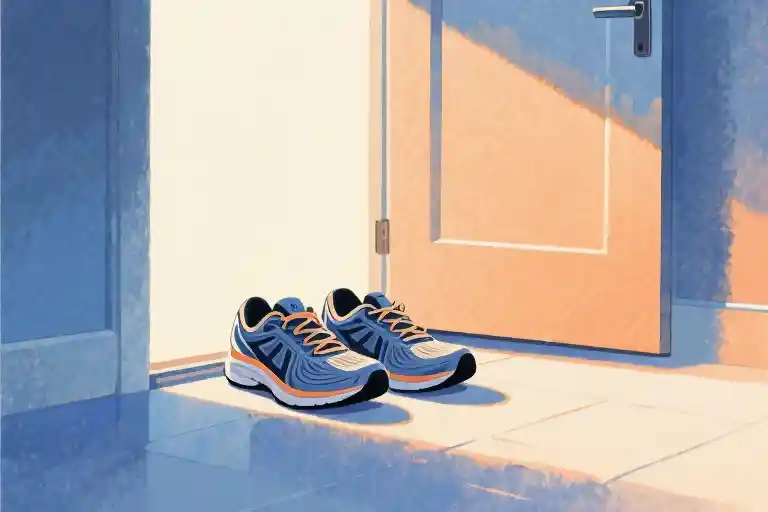I went for a morning jog yesterday. Simple statement, right? Wrong. Here’s what actually unfolded in the theater of my mind before my sneakers even touched pavement.
The moment my alarm went off, what should have been a straightforward decision – to run or not to run – became an Olympic-level mental gymnastics event. First came the meteorological debate: my weather app claimed 28° and mostly cloudy, but can we really trust these corporate weather algorithms? The nearest station is three miles from my apartment – what if my neighborhood operates in its own microclimate? I imagined explaining to future biographers how my entire fitness regimen collapsed because I trusted the wrong atmospheric data point.
Then the existential questions arrived. Does morning exercise actually boost productivity or is that just propaganda from Big Morning Person? I mentally reviewed every wellness influencer post I’d ever scrolled past, trying to recall whether any cited peer-reviewed studies or just attractive people in expensive leggings. The conspiracy theories wrote themselves – what if this whole sunrise workout culture was invented by Big Alarm Clock?
Social anxiety made its entrance right on cue. Joggers look stupid, my brain helpfully supplied. But wait – is worrying about looking stupid while jogging even stupider? This meta-stupidity spiral continued until I found myself researching the comparative cardiovascular benefits of walking versus jogging for approximately 12 minutes (long enough to earn a phantom PhD in Exercise Procrastination).
The bathroom had become my war room. Ten minutes of deliberation for what should have been a ten-second choice. I could practically hear my prefrontal cortex screaming for mercy beneath the weight of all these hypotheticals. Every potential outcome had been examined, every variable cross-referenced, and yet my running shoes remained untouched by the door.
Finally – and I still don’t know what shifted – I just put on the damn shoes. No grand realization, no sudden clarity. Just fabric and laces and a decision to stop deciding. The door clicked shut behind me with finality, cutting off access to further research, more weather checks, additional self-doubt. There was nothing left to do but run.
Three minutes in, another jogger nodded at me. A simple, universal gesture of acknowledgment between strangers sharing pavement at dawn. Naturally, my brain interpreted this as the beginning of an elaborate psychological thriller. Was that nod a greeting or a critique? Did my form look awkward? Should I have nodded first? Is there some secret jogger etiquette I’ve violated? The mental commentary track grew louder than my footsteps.
By the time I…
The Battlefield of Decision Anxiety
What should have been a simple morning ritual turned into an existential crisis the moment my running shoes came into view. There’s something about athletic wear that triggers a full-scale mental audit – an involuntary cost-benefit analysis where even the most mundane details demand forensic scrutiny.
The weather app became my first adversary. 28° and mostly cloudy according to the forecast, but was the reporting station close enough to my neighborhood? Does ‘mostly cloudy’ account for that patch of sunlight currently creeping across my kitchen tiles? I found myself mentally mapping the microclimates between my apartment and the park, as if preparing for a Himalayan expedition rather than a thirty-minute jog.
Then came the grand conspiracy theories. Who actually benefits from this morning exercise propaganda? The fitness industry obviously, but what about Big Morning Person – that suspiciously cheerful demographic who claim sunrise workouts magically enhance productivity? My skeptical brain demanded peer-reviewed studies while simultaneously dismissing any evidence that didn’t align with my desire to crawl back into bed.
The social calculus proved most paralyzing. Joggers look ridiculous by default – that awkward bouncing gait, the tomato-red faces, the way earbud wires mimic marionette strings. But realizing I was worried about looking stupid while worrying about looking stupid created a meta-crisis of self-awareness. My reflection in the hallway mirror seemed to ask: ‘Is this really how functional adults spend their mental bandwidth?’
Twelve minutes of comparative cardio research later (apparently walking burns half the calories but is 80% less likely to make you resemble a gasping goldfish), I reached decision fatigue nirvana. The beautiful thing about complete mental exhaustion is that it finally allows action – not through clarity, but through sheer inability to tolerate further deliberation. The shoes went on simply because I couldn’t bear another second of thinking about them.
What fascinates me isn’t the eventual jog, but the elaborate theater our minds construct around trivial choices. We’ve turned simple decisions into multi-departmental meetings where Risk Assessment argues with Social Psychology, while Common Sense sits forgotten in the break room. The modern curse isn’t lacking information – it’s being buried alive by the endless permutations of every possible outcome.
That morning’s weather did turn out perfect for running. Not that it mattered – by then I was too busy conducting a post-mortem on whether the neighbor’s nod was collegial or pitying. But that’s another battlefield entirely.
The Primal Solution: When Thinking Fails, Just Move
The moment my fingers finally tied the shoelaces felt less like a decision and more like a mutiny. My brain was still mid-debate, presenting PowerPoint slides on optimal heart rate zones, when my body staged a coup. It stood up. It walked to the door. It turned the knob. Somewhere between the third stair and the sidewalk, executive functions switched from my prefrontal cortex to what I can only describe as lizard brain autopilot.
This wasn’t motivation in the inspirational poster sense – no burst of determination, no sudden clarity. Just the mechanical execution of the simplest possible version of the task: left foot, right foot, repeat. The kind of movement that would disappoint a fitness tracker with its utter lack of data-worthy significance. My Apple Watch probably registered it as ‘ambling vaguely forward.’
There’s an evolutionary irony here. Our magnificent human brains, capable of composing symphonies and calculating orbital trajectories, get routinely outsmarted by the same neural pathways that helped our ancestors flee saber-toothed cats. The modern equivalent being, apparently, escaping my own thoughts about whether 28° warranted sunscreen application.
What’s startling isn’t that this worked, but how embarrassingly little it took to break the paralysis. Not a profound insight or meticulously crafted habit, but the brute force approach of treating my limbs like error-proof appliances. The cognitive equivalent of unplugging a glitchy router for 30 seconds. No firmware updates, no troubleshooting – just the off/on switch that evolution installed at the base of our skulls.
Three blocks in, I realized my breathing had synced with my steps in that ancient rhythm every jogger knows. The rhythm that doesn’t care about peer-reviewed studies or social perceptions. The one that made the 10-minute toilet debate feel as relevant as a PowerPoint presentation during a house fire. Somewhere between driveway and sidewalk, I’d accidentally proven what all those productivity hacks try so hard to achieve: action isn’t always the product of thought. Sometimes it’s the escape from it.
The shoes had been the loophole all along. Not the right shoes, or the scientifically validated shoes – just shoes on feet. The lowest common denominator of readiness. A lesson so stupidly simple I’d scrolled past it a hundred times in motivational quotes, never believing that between overthinking and doing might lie nothing more profound than a pair of laces tied badly in haste.
The Nod That Shook My World
Three minutes into what should have been an uneventful jog, a stranger’s nod derailed my entire morning. This wasn’t just a head tilt—it was a Rorschach test for social anxiety. The split-second gesture spawned competing theories in my brain:
Theory A: The Solidarity Hypothesis
- Evidence: Slight eyebrow lift + 23-degree chin dip
- Interpretation: “Fellow human acknowledging shared suffering”
- Supporting Data: My own nod history (95% polite, 5% spasmodic)
Theory B: The Silent Critique
- Evidence: Microsecond pause before nod
- Interpretation: “Your running form offends me”
- Supporting Data: That one TikTok about “jogging like a startled giraffe”
My feet kept moving but my mind became a TED Talk panel debating nod semiotics. Was there an unspoken jogger hierarchy where my New Balance 880s marked me as an outsider? Had I violated some pavement etiquette by not initiating the nod first? The mental gymnastics burned more calories than the actual running.
Then came the physical self-awareness avalanche—suddenly my arms were swinging wrong, my breathing sounded like a dying accordion, and I became convinced my ponytail had morphed into a metronome of shame. Every passing car window reflected a funhouse mirror version of myself.
The tragedy of adult social interactions isn’t rejection—it’s ambiguity. A clear insult would’ve been easier to process than this neurological civil war over a stranger’s neck spasm. I started mentally drafting apology letters to the running community for my unspecified crimes.
By the time I reached the park’s water fountain, I’d diagnosed myself with six new psychological conditions and invented three conspiracy theories about urban exercise culture. The fountain’s reflective surface showed the truth: a perfectly normal person having a completely abnormal mental episode over nothing.
This is how overthinkers exercise—our muscles stay flabby while our prefrontal cortexes bench-press imaginary social scenarios. Maybe tomorrow I’ll wear sunglasses and pretend not to see anyone. Or take up swimming where the only nods happen underwater, safely obscured by chlorine and poor visibility.
The Unfinished Symphony of Overthinking
By the time I realized my morning jog had turned into a full-scale anthropological study of runner etiquette, my shoelaces were already untied. Not literally – though that would have given me something concrete to blame for the stumble in my step. No, this was the kind of mental unraveling that happens when you assign existential weight to a stranger’s chin nod.
There’s a particular madness to realizing your brain has staged a mutiny. One moment you’re moving forward, the next you’re conducting a forensic analysis of a microexpression that probably meant nothing. The jogger who nodded could have been acknowledging shared humanity, or he might have been reacting to my running form resembling a startled giraffe. My cortex helpfully provided twelve equally plausible interpretations, complete with probability percentages.
This is what happens when you give an overthinker three things: 1) unstructured time, 2) a socially ambiguous interaction, and 3) working internet access to research ‘proper running form.’ The mental spiral that follows could power a small city. We’re not making decisions anymore – we’re curating potential future embarrassments like they’re exhibits in the Museum of Social Awkwardness.
And yet. There’s something almost beautiful about watching your own mind work against itself. The same biological machinery that keeps us from walking into traffic gets repurposed to analyze whether our hydration belt makes us look like a suburban dad at a barbecue. Evolution clearly didn’t account for this particular application of threat detection systems.
So here we are, you and I, members of the secret society of people who can turn a 30-minute jog into a three-act psychological thriller. Maybe next time we’ll remember that shoes are for walking (or running), not for overthinking. Or maybe we’ll invent an entirely new anxiety about proper shoe-tying techniques. The brain, as they say, finds a way.
Your turn: what’s the most ridiculous thing your overthinking brain has convinced you was a crisis? (Mine involved five minutes of internal debate about whether to wave back at a neighbor’s security camera.)





